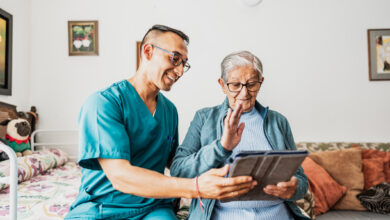Beyond COVID-19: How can we prepare the nursing workforce for the new reality?

As a former nurse, it breaks my heart to know that more than 600 nurses have lost their lives fighting the COVID-19 pandemic. Over the past month, as part of the Future of Healthcare webinar series, I have spoken to many healthcare leaders to discuss how we can learn from the current pandemic and futureproof our healthcare systems. It was striking to hear from our presenters, including Karen Blake, head of clinical informatics, healthAlliance and Kate Renzenbrink, chief nursing and midwifery information officer at Bendigo Health, during the series how regions, like South Korea, who had first-hand experience of the SARS or MERS epidemics, and others that locked down fast had significantly lower transmission rates and associated mortality rates compared to others.
In life, there is often a reluctance to accept advice from others, especially from country to country. However, nurses around the world are willing to look to their colleagues for advice and support to learn from each other’s experience.
As Karen Blake voiced in our discussion, we need to learn from our past and equip the nursing workforce to be prepared for the next emergency or crisis. Now is the time to evaluate and act on how we can build up the capabilities of our nursing workforce with better clarity to prepare them for the future reality of healthcare.
Enhancing nursing workflow with technology for patient-centric care model
Due to the pandemic, many hospitals have shifted their care delivery models to mitigate the risk of infection. In merely six weeks between April and May this year, there were close to 3,000 telehealth appointments at Bendigo Health, according to Kate Renzenbrink. This is a marked increase from less than 200 appointments made last year.
Care delivery, especially for elective procedures, is becoming de-hospitalised from the acute hospital to the community as providers adopt patient-centric care (PCC) models.
Under the PCC delivery model, care is organised around the patient and puts the patient at the forefront of care decisions and actions. With the rise of digital health technologies including telehealth services, mobile apps, and wearables, patients are more informed and engaged in their own health than ever before, and this is changing the dynamics of care provision and patient-clinician interactions.
As nurses work towards delivering care through PCC, they are taking on more active roles in educating and supporting patients and their caregivers with the right information to make the most informed decision about their own health. In these roles, nurses need ready access to knowledge, which is now delivered via technology. Care plans, which are integrated into electronic health record (EHR) systems, allow nurses to have quick access to past history and evidence-based knowledge, enabling them to provide better care for patients, reducing information variability and preventing potential omissions of care.
The bottom line is that digital health technology has the capability to deliver relevant knowledge to nurses, which supports them in fulfilling the PCC model.
Building digital health capabilities in the nursing workforce
For the vast benefits that technology brings in supporting nurses to provide better care, there is a need for organisations to invest in upskilling the digital capabilities of their nursing workforce. In a live poll conducted during one of Elsevier’s ‘The Future of Healthcare’ webinars, the majority of the participants (82 per cent) felt that in the next two years, there will be better funding to continue education and upskilling the digital literacy of nurses.
One of the gaps we have identified across the healthcare sector is digital literacy. As we become a more digitised workforce, how do we start enabling our existing workforce to embrace new ways of working?” – Karen Blake, head of clinical informatics, healthAlliance
Organisations need to understand the diverse knowledge levels surrounding information technology (IT) that exist within their current nursing workforce.
In New Zealand, the nursing workforce is older, with 43 per cent aged 50 or above[i]. Similarly, in Australia, about 49 per cent of the nursing workforce is aged 45 or above[ii]. Thus, on-going education and upskilling support needs to take into consideration generational gaps that exist in digital literacy and be willing to provide appropriate training and education programmes best suited for existing skills and abilities.
Apart from enhancing the digital capabilities of the existing nursing workforce, onboarding needs to constantly evolve to prepare new nurses for skills and roles that may not have been conceived today. To support nurses in delivering evidence-based, knowledge-driven care, they need to be trained in Clinical Decision Support (CDS) tools, which integrate with existing EHR systems. These tools help nurses access the latest evidence-based guidelines and care plans so that they can make data-enabled and efficient clinical decisions for their patients.
Whether it is upskilling the existing nursing workforce or preparing future generations to be digitally equipped for new roles, technology enables nurses to deliver the best care for their patients while futureproofing for emergency situations.
Opening career pathways and leadership opportunities
COVID-19 has put healthcare systems under immense pressure and many nurses have had to step up to provide increased levels of care alongside their teams of physicians and other clinicians. Nurses are often the closest point-of-contact at the bedside and serve as critical voices for patients.
Their integral contributions to care delivery should be extended to leadership roles, especially in digital health. With the increased usage of digital tools and technology, nurses today are leveraging data and technology to lead improvements in patient care. Nursing informatics, for example, is a new speciality where nurses study patient data to make knowledge-driven decisions for their patients.
Florence Nightingale is the pioneer in informatics specialisation. She used data to show how we can change healthcare and save lives. We need to start recognizing nursing informatics specialists today.” – Kate Renzenbrink, chief nursing and midwifery information officer at Bendigo Health
Investing and advocating for the expansion of nursing leadership roles is more critical than ever today. As we commemorate 200 years of nursing this year, we are reminded that the world needs another 5.9 million nurses globally[iii].
One in five New Zealand nurses are looking to retire in the next five years, causing a potential threat to healthcare staffing[iv]. Nursing workforce projections in Australia have also estimated a shortfall of approximately 123,000 nurses in the next 10 years[v]. Having nursing voices in leadership and decision-making can help to support retention policies and ensure that we continue supporting future generations of nurses.
Life after COVID-19 will never be the same and the nursing profession will also evolve. This new reality calls for the development of a future-ready nursing workforce. Equipping our nurses with digital competencies and technology to support care delivery can go a long way in advancing the nursing practice and creating a healthy, productive work environment.
Through the many health crises that have plagued us for centuries, nurses have raised their hands and stood at the frontline to save and improve lives. That is what nurses do. It is time we recognise their value and equip them with technology, so that they can continue pushing the boundaries in healthcare.

Tim Morris is the commercial portfolio and partnership director at Elsevier, working as the experienced healthcare professional in Clinical Decision Support & Hospital Workflow Solutions across the EMEA/LA region.
[i] Workforce Statistics Nursing 2018-2019. Nursing Council of New Zealand. https://www.nursingcouncil.org.nz/Public/Publications/Workforce_Statistics/NCNZ/publications-section/Workforce_statistics.aspx?hkey=3f3f39c4-c909-4d1d-b87f-e6270b531145
[ii] Nursing and Midwife 2018/19 Annual report. Retrieved from: https://www.nursingmidwiferyboard.gov.au/News/Annual-report.aspx
[iii] https://www.who.int/publications-detail/nursing-report-2020
[iv] https://www.stuff.co.nz/manawatu-standard/news/119076596/new-generation-of-nurses-needed-as-staffing-crisis-threatens
[v] Australia’s Future Health Workforce – Nurses reports (2012). Retrieved from: https://www1.health.gov.au/internet/main/publishing.nsf/Content/australias-future-health-workforce-nurses
Email: [email protected]





